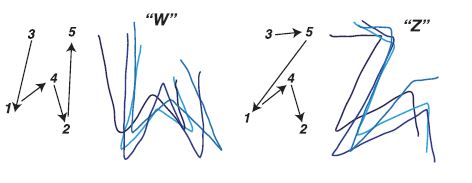Blind people could 'see' letters that scientists drew on their brains with electricity
The scientists stimulated the brain using electrodes implanted on its surface.

Scientists sent patterns of electricity coursing across people's brains, coaxing their brains to see letters that weren't there.
The experiment worked in both sighted people and blind participants who had lost their sight in adulthood, according to the study, published today (May 14) in the journal Cell. Although this technology remains in its early days, implanted devices could potentially be used in the future to stimulate the brain and somewhat restore people's vision.
Known as visual prosthetics, the implants were placed on the visual cortex and then stimulated in a pattern to "trace" out shapes that the participants could then "see." More advanced versions of these implants could work similarly to cochlear implants, which stimulate nerves of the inner ear with electrodes to help enhance the wearer's hearing ability.
Related: From dino brains to thought control — 10 fascinating brain findings
"An early iteration [of such a device] could provide detection of the contours of shapes encountered," study authors neuroscientist Michael Beauchamp and neurosurgeon Dr. Daniel Yoshor, both at the Baylor College of Medicine, told Live Science in an email. (Yoshor will start a new position at the Perelman School of Medicine at the University of Pennsylvania this summer.) "The ability to detect the form of a family member or to allow more independent navigation would be a wonderful advance for many blind patients."
The current study represents a small step toward realizing such technology.
Seeing stars
The study authors crafted the letters by stimulating the brain with electrical currents, causing it to generate so-called phosphenes — tiny pinpricks of light that people sometimes perceive without any actual light entering their eyes. Unlike when light bounces off an object in the room and enters your eyes, phosphenes appear as a quirk of the visual processing system; you "see" these points of light even though they're not actually there. For instance, you may have seen phosphenes when you rub your eyes in a dark room, a phenomenon often described as "seeing stars," the authors said.
Get the world’s most fascinating discoveries delivered straight to your inbox.
Known as "mechanical phosphenes," the stars that appear when you rub your eyes were first described by an ancient Greek philosopher and physiologist named Alcmaeon, said John Pezaris, the head of the Visual Prosthesis Laboratory at Massachusetts General Hospital and an assistant professor of neurosurgery at Harvard University. Centuries later, in 1755, French physician Charles Le Roy discovered that stimulating the brain with electricity could also produce vivid phosphenes, even in blind individuals, said Pezaris, who was not involved in the study.
Related: Inside the brain: A photo journey through time
In the 1960s, scientists began running with the idea of visual prosthetics, Pezaris said; researchers implanted electrodes in the visual cortex — a brain region that processes incoming information from the eyes — with the goal of generating phosphenes and assembling them into coherent shapes. Scientists assumed that, if they stimulated multiple spots on the cortex, multiple phosphenes would appear and "automatically coalesce" into intelligible forms, much like individual pixels on a computer screen, the authors noted.
"But the brain is far more complex than a computer display, and for reasons that we don't yet fully understand, it is actually very difficult to produce recognizable forms from phosphene combinations," Beauchamp and Yoshor said. The authors ran into the same roadblock during their own study, but found a way to circumvent it.
Drawing on the brain
The team laid an array of electrodes over the visual cortices of five study participants, three sighted and two blind. Specifically, the electrodes sat over a region of the brain known as V1, where information from the retinas gets funneled for early processing. The sighted individuals were already undergoing surgery to have electrodes implanted in their brains as part of an epilepsy treatment, designed to monitor their brains for seizure activity. The blind individuals had participated in a separate study investigating visual prosthetics and had the electrodes implanted at that time.
V1 works like a map, where different regions of the map correspond to the different zones of our visual field, such as the upper right or the lower left. The authors found that, if they activated one electrode at a time, participants reliably saw a phosphene (pinprick of light) appear in its predicted zone. But if multiple electrodes came online simultaneously, the individual phosphenes still appeared but did not come together as coherent shapes.
So the authors tried a different strategy; they hypothesized that by "sweeping an electrical current across" several electrodes they could trace patterns onto the surface of the brain and thus generate recognizable shapes. "The brain is uniquely tuned to detect changes in our environment," so they theorized that the organ should track a pattern of phosphenes presented one after the other, the authors said.
Cochlear implants use a similar strategy to generate different auditory tones, Pieter Roelfsema, director of the Netherlands Institute for Neuroscience, who was not involved in the study, told Live Science in an email. "Suppose that electrode 1 gives a high pitch and electrode 2 a somewhat lower pitch," he said. By directing an electrical current through both electrodes, "you can get a pitch intermediate between that of electrodes 1 and 2."
The study authors found that they could do something similar with vision; they could generate phosphenes between the locations of two separate electrodes, thus connecting the dots between them. With this technique, the authors drew letter shapes, such as "W," "S" and "Z", onto the surface of V1; the shapes had to be drawn upside-down and backwards, which is how visual information usually reaches the visual cortex from our eyes.
In the end, the study participants could see the traced shapes and accurately recreate them on a touch screen. When participants in the study began seeing letters form in their minds' eyes, "I think they were at least as excited as we were, probably more!" Beauchamp and Yoshor told Live Science.

Looking to the future
"There are still a number of challenges to be overcome" before the research can be applied in useful visual prosthetics, Roelfsema wrote in a letter in the journal Cell accompanying the new paper.
In the future, visual prosthetics will likely contain "many thousands of electrodes," whereas the study only used a few dozen, the authors said. In addition, "these electrodes may be designed to penetrate the cortex so that the electrode tips are closer to the neurons that lie several hundred microns below the cortical surface," they added.
Electrodes that penetrate the brain generate more precise phosphenes with weaker electrical fields than those required by electrodes on the surface of the brain, Pezaris said. Surface electrodes use strong electrical fields to reach brain cells within the tissue, sometimes causing adjacent or overlapping cells to become stimulated at the same time, he noted.
For visual prostheses to work, new electrodes will need to be invented that remain compatible with brain tissue for extended periods of time, Roelfsema told Live Science. "The current ones going into the brain cause damage and do not work long enough," he said.For certain patients, however, surface electrodes may work best, depending on the risks associated with implanting electrodes deeper in their brains, Pezaris said. "There are so many different causes of blindness" that some patients may benefit most from deeply implanted electrodes, others from surface electrodes and still others from prosthetics implanted directly into the retinas, which only require eye surgery to implant, he said.
Above all, "to make visual prosthetic devices really useful for blind patients, they have to improve quality of life," Beauchamp and Yoshor said. That means that, beyond optimizing the physical electrodes and how they operate, scientists will have to develop reliable software that helps filter and process visual information for the user. And once assembled, the complete system must be useful enough that people actually use it.
"Fundamentally, one of the things we have to keep in mind is that blindness is not a life-threatening condition and therefore the risks need to be balanced out with sufficient benefits," Pezaris said of visual prosthetics.
- 25 strangest sights on Google Earth
- 10 things every woman should know about a man's brain
- 'Eye' can't look: 9 eyeball injuries that will make you squirm
Originally published on Live Science.
OFFER: Save 45% on 'How It Works' 'All About Space' and 'All About History'!
For a limited time, you can take out a digital subscription to any of our best-selling science magazines for just $2.38 per month, or 45% off the standard price for the first three months.

Nicoletta Lanese is the health channel editor at Live Science and was previously a news editor and staff writer at the site. She holds a graduate certificate in science communication from UC Santa Cruz and degrees in neuroscience and dance from the University of Florida. Her work has appeared in The Scientist, Science News, the Mercury News, Mongabay and Stanford Medicine Magazine, among other outlets. Based in NYC, she also remains heavily involved in dance and performs in local choreographers' work.

